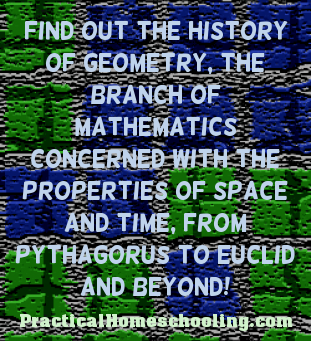 Once a student has mastered arithmetic, including fractions and decimals, the next subject to tackle is Algebra, in which symbols are used to represent unknown quantities. After Algebra comes Geometry. Geometry, of course, is used in many professions involving physics, engineering, architecture, space exploration, and anything that requires measurement. It was used by the ancient Greeks and the Egyptians in building their huge monuments and temples.
Once a student has mastered arithmetic, including fractions and decimals, the next subject to tackle is Algebra, in which symbols are used to represent unknown quantities. After Algebra comes Geometry. Geometry, of course, is used in many professions involving physics, engineering, architecture, space exploration, and anything that requires measurement. It was used by the ancient Greeks and the Egyptians in building their huge monuments and temples.
What is geometry? It is a branch of mathematics concerned with the properties of space and shapes. According to Yale Prof. Elias Loomis, author of one of the most widely used textbooks on Geometry in the 19th century, the term Geometry is derived from a Greek word, meaning the "science of land-measuring." Ancient writers generally supposed that this science was first cultivated in Egypt. Aristotle attributed the invention to the Egyptian priests, who had abundant leisure for study. Pythagoras, born 580 years B.C., was one of the earliest cultivators of Geometry. He discovered that the circle has a greater area than any other plane figure having an equal perimeter, and that a sphere has a similar property among solids.
The most remarkable epoch in the history of Geometry was the establishment of the school of Alexandria, about 300 B.C. It was here that the celebrated geometer Euclid flourished under the first of the Ptolemies. He is best known for his Elements, a work on Geometry and Arithmetic in thirteen books, under which he collected all the elementary truths of Geometry which were found before his time. It is only the first six books and the eleventh and twelfth books that are much used in schools.
The first four books teach the properties of plane figures; the fifth contains the theory of proportion; and the sixth its application to plane figures; the seventh, eighth, ninth, and tenth relate to Arithmetic and the doctrine of incommensurables; the eleventh and twelfth contain the elements of the geometry of solids; and the thirteenth discusses the five regular solids.
In Euclidean geometry the space corresponds to common ideas of physical space, and the shapes are idealizations of the common shapes that occur in real life. Parallel lines never meet and the angles in a triangle always add up to 180 degrees. The geometry of physical space can be assumed for most purposes to be Euclidean.
There are other branches of Geometry. Non-Euclidean geometry deals with the surface of a sphere to which Euclid's postulates do not apply. In Euclidean geometry two lines at right angles to a third remain parallel and never meet. In hyperbolic or elliptic geometry the two lines eventually diverge or converge.
Then there is Riemannian geometry, which is used in relativity theory. It involves the development of a generalized space of any dimensions in which measurements may vary from point to point. Used by Einstein in his general theory of relativity, it was invented by a German mathematician, Georg Riemann, in the mid-19th century.
There is also Analytic Geometry, in which algebra is used to solve geometrical problems. Geometrical figures are placed in a coordinate system, each point in the figure being represented by its coordinates, which satisfy an algebraic equation. It is also known as coordinate geometry or Cartesian geometry, after its inventor Rene Descartes.
In Cartesian coordinates, a point is located by its distance from intersecting lines called axes. In a two-dimensional plane there are two axes and in three-dimensional space there are three. Usually the axes are at right angles to each other and are known as rectangular axes, but oblique axes are also used in exceptional circumstances.
However, to begin with, you will want to concentrate on elementary Euclidean geometry. Thomas Hill wrote an elementary text back in 1855 entitled in First Lessons in Geometry. He wrote in his Preface:
I have addressed the child's imagination, rather than his reason, because I wished to teach him to conceive of forms. The child's powers of sensation are developed before his powers of conception, and these before his reasoning powers. This is, therefore, the true order of education.
You might consider Hill's views when introducing geometry to your child. He also writes:
Geometry is the most useful of all the sciences. To understand Geometry, will be a great help in learning all the other sciences; and no other science can be learned unless you know something of Geometry. To study it, will make your eye quicker in seeing things, and your hand steadier in doing things. You can draw better, write better; cut out clothes, make boots and shoes, work at any mechanical trade, or learn any art, the better for understanding Geometry.
That was written in 1855. Studying the history of Geometry may get your child more interested in the subject than merely plunging into Euclid's Elements. We believe that 19th century professors wrote better books on Geometry than those writing today. You might search an antiquarian bookshop for a good 19th century Geometry textbook. Prof. Elias Loomis's Elements of Geometry, Conic Sections and Plane Trigonometry, was published in a revised edition in 1888. See if you can find one.
However, if you must buy a modern text, try A Beka Books, Bob Jones University, and other reliable sources of homeschool materials. Their textbooks are usually quite good.